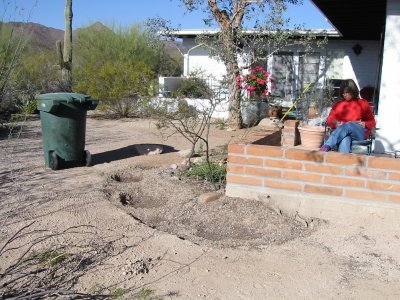 Here are two of my beds one year later. The chicken wire was attached to rebar and wood stakes to keep the rabbits out. Note that there are rubber protectors on top of the rebar to protect against someone falling on one and impalling themselves. Not much you can do about Javalina as they can jump easily over the fence. My mixture of dirt to compost is one to three (one part compost, two part dirt). The mesquites came from 5 gallon pots and were placed in holes twice as deep as the 18"bed. Plants used included salvia leucantha, salvia greggi, ruelia, mexican sunflower, casia and mexican primrose and many other desert varieties. Desert Survivors Nursery on West 22nd St. near A Mountain is wonderful place to purchase plants. They grow their plants on site, a big plus since your plant will have had plenty of time to acclimate to Tucson's climate. I also recommend using rocks and boulders in your beds. They give your garden texture and provide a natural setting for plants. Boulders also shelter roots from the hot sun.
Here are two of my beds one year later. The chicken wire was attached to rebar and wood stakes to keep the rabbits out. Note that there are rubber protectors on top of the rebar to protect against someone falling on one and impalling themselves. Not much you can do about Javalina as they can jump easily over the fence. My mixture of dirt to compost is one to three (one part compost, two part dirt). The mesquites came from 5 gallon pots and were placed in holes twice as deep as the 18"bed. Plants used included salvia leucantha, salvia greggi, ruelia, mexican sunflower, casia and mexican primrose and many other desert varieties. Desert Survivors Nursery on West 22nd St. near A Mountain is wonderful place to purchase plants. They grow their plants on site, a big plus since your plant will have had plenty of time to acclimate to Tucson's climate. I also recommend using rocks and boulders in your beds. They give your garden texture and provide a natural setting for plants. Boulders also shelter roots from the hot sun. I've used drip irrigation throughout my landscape. You can see the black hose on top of the bed in the photo. In most cases I leave the main hose above ground to allow easy access. You can now purchase emitters that allow variable water flow - a great invention! Each plant type will require a little more or a little less water than another plant type and with adjustible flow emitters you can now fine tune the plant's watering needs. Drip is a very easy and effective way to water your garden while conserving Tucson's precious water.




